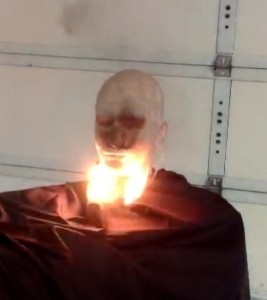-
 Minnesota
MinnesotaMustaches, Home Oxygen Therapy, Sparks Do Not Mix
June is Home Safety Month; July 4 fireworks also cause for special attention to risk
 Facial hair and home oxygen therapy can prove a dangerously combustible combination, a Mayo Clinic report published in the peer-reviewed medical journal Mayo Clinic Proceedings finds. To reach that conclusion, researchers reviewed home oxygen therapy-related burn cases and experimented with a mustachioed mannequin, a facial hair-free mannequin, nasal oxygen tubes and sparks. They found that facial hair raises the risk of home oxygen therapy-related burns, and encourage health care providers to counsel patients about the risk.
Facial hair and home oxygen therapy can prove a dangerously combustible combination, a Mayo Clinic report published in the peer-reviewed medical journal Mayo Clinic Proceedings finds. To reach that conclusion, researchers reviewed home oxygen therapy-related burn cases and experimented with a mustachioed mannequin, a facial hair-free mannequin, nasal oxygen tubes and sparks. They found that facial hair raises the risk of home oxygen therapy-related burns, and encourage health care providers to counsel patients about the risk.
More than 1 million people in the United States use home oxygen therapy, and it is on the rise around the world, especially in countries where smoking is increasing, the researchers say.
Mustaches and other facial hair can act as kindling for nasal oxygen tubes when a spark joins the mix, even if the spark is just a tiny ember that flies at an oxygen tank user from a match, grill or fireworks.
“They can have very bad facial burns and airway burns also,” says senior author Andrew Greenlund, M.D., Ph.D., a Mayo Clinic primary care physician who conducted the research with his wife, Mayo physician Laura Greenlund, M.D., Ph.D., and Mayo medical resident Bradley Anderson, M.D. “When fire burns the airway, then you have swelling and tissue death. It can be very dangerous.”
Using the Greenlunds’ garage, the researchers experimented with a mannequin with a mustache made from human hair and a mannequin without facial hair. They drilled nostrils into the mannequins and inserted nasal tubes, known as nasal cannula tubing, and connected the tubes to a home oxygen tank. With oxygen flowing at 2 liters per minute, a level similar to that used in home oxygen therapy, they exposed the mannequins to sparks. The nasal oxygen tubes on the facial hair-free model didn’t ignite; on the mustachioed mannequin, the oxygen tubes ignited and the mustache went up in flames.
The researchers’ review of Mayo medical charts found nine men with home oxygen therapy-related burns between 1994 and 2013: Eight of the nine had facial hair when they were burned.
Dr. Greenlund has treated home oxygen therapy patients whose nasal oxygen tubes ignited while they were grinding lawn mower blades, were hit in the mustache by an ember when someone else lit a match or were smoking.
“It can be what you might think are innocuous or benign things,” Dr. Andrew Greenlund says of potential ignition sources. “But with the facial hair and oxygen, it can be a real risk.”
The Mayo findings are supported by an earlier study by National Aeronautics and Space Administration researchers. They found that while hair is only marginally flammable in normal room air, the risk rises exponentially in an oxygen-enriched environment.
Patients receiving home oxygen therapy can lower their risk of burns by shaving facial hair, using water-based hair gels rather than hair products that contain alcohol or oil, using humidified oxygen, and of course by avoiding sparks and flames, the researchers say.
###
About Mayo Clinic
Recognizing 150 years of serving humanity in 2014, Mayo Clinic is a nonprofit worldwide leader in medical care, research and education for people from all walks of life. For more information, visit 150years.mayoclinic.org, MayoClinic.org or https://newsnetwork.mayoclinic.org/.
About Mayo Clinic Proceedings
Mayo Clinic Proceedings is a monthly peer-reviewed medical journal that publishes original articles and reviews dealing with clinical and laboratory medicine, clinical research, basic science research and clinical epidemiology. Proceedings is sponsored by the Mayo Foundation for Medical Education and Research as part of its commitment to physician education. It publishes submissions from authors worldwide. The journal has been published for more than 80 years and has a circulation of 130,000. Articles are available online at www.mayoclinicproceedings.org.
JOURNALISTS: Video of the experiments and sound bites of Dr. Greenlund are available in the downloads below. To interview Dr. Greenlund, please contact Sharon Theimer in Mayo Clinic Public Affairs at 507-284-5005 or newsbureau@mayo.edu.







